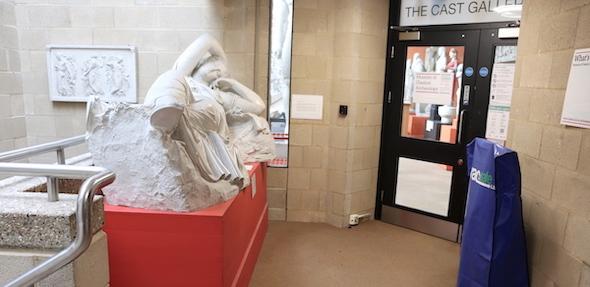
We know that some of our visitors will have concerns about gaining access to the Cast Gallery and our collection.
We want everyone to be able to access our collection and activities, and to enjoy their visit. We hope the information on this page will help visitors with physical, sensory and learning disabilities.
If there is something you feel we could improve or if you have a question which is not answered here, please do get in touch. If you require personalised assistance, we will do our very best to provide it.
Tel. +44 (0)1223 330402
Email museum@classics.cam.ac.uk
If for any reason, you find our staff are not able to answer your enquiry with the information that you need, please ask to be put in touch with the Curator, Dr Susanne Turner. Please mention your preferred method of contact, too, so that we can ensure we meet your needs.
Lift out of order
Our lift is currently out of order which means we are not able to provide step-free access at present.
Update: we hope to be able to restore access in mid-August.
Location
- The Museum is located on the first floor of the Faculty of Classics, in the University of Cambridge's Sidgwick Site.
- There are pedestrian and vehicle entrances to the Sidgwick Site from Sidgwick Avenue. Sidgwick Avenue is a tree-lined street with uneven and narrow pavements in places.
- There is level, paved access to the building itself with a dropped curb in front of the building
- Disabled access to the Museum is via a separate entrance and lift.
- The Cast Gallery, our main display space, is on one level and is a wide and open space, with minimal obstructions.
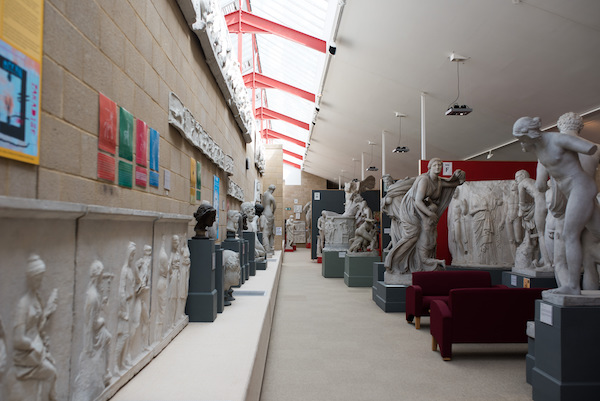
The interior of the Museum's Cast Gallery is light and lit from above. It is carpeted with wide throughways, although some routes between casts in the Bays are narrower.
Accessible Parking
- There are two disabled parking bays near the Museum on the Sidgwick Site.
- Both are located in the main car park, giving you easy access to the museum.
- Disabled parking bays are marked on the accessibility map of the Sidgwick Site, available above.
Entrance
- The entrance to the Museum is via the Faculty of Classics, inside the Sidgwick Site.
- There is no entrance on the road.
- The glass doors can be opened automatically by pressing the disabled access button outside the entrance.
- The manifestations on the glass doors are not very clear.
- There are push buttons to open the doors.

Museum Main Entrance: there is level paving outside and access is via two sets of glass doors.
Main Entrance
- The main entrance to the Museum is through the foyer of the Faculty of Classics.
- The entrance lobby is carpeted and then the main foyer has a tiled floor and a red anti-slip rug. There are no busy carpet patterns, but there are differences in shade and texture.
- There are push buttons to open the two sets of glass doors.
- Access to the Museum here is via a staircase.
- Turn left at the top of the staircase to find the main doors to the Museum of Classical Archaeology's Cast Gallery.
- The doors to the Cast Gallery are heavy and do not open automatically.

Access to the Museum is via the main foyer of the Faculty of Classics and up the stairs to the left.
Step-Free Entrance
- Step-free access can be faciliated through an alternative entrance, where the lift is located. This entrance to the building has a ramp and handrails.
- There are push buttons to open the doors at the entrance and also on the route through the building.

Museum step-free entrance: step-free access is via a different door, with a ramp.
Lift
Lift out of order
Our lift is currently out of order which means we are not able to provide step-free access at present.
- We recommend calling in advance to check that our lift is fully functional.
- A lift is available for step-free access.
- The lift is located in a separate entrance to the building, a short walk from the main entrance.
- We ask that visitors who require step-free access please stop at the Enquiries Office on entry to request that a member of Museum staff come down to guide them through the building.
- In the event that the Enquiries Office is unstaffed during opening hours, please call the Museum on 01223 330402 or use the red phone in the entrance lobby.

The building has a small person lift, with an entrance 80cm wide, which fits up to 6 people.
Information Desk
- There is an Enquiries Office located to your left as you enter the main foyer of the Classics building. There is a bell to ring if you require assistance, for instance, access to the lift.
- In the Museum, the Front Desk is located as you come through the main doors. Staff here are happy to help with any questions you may have.
Staff Training
- Core museum staff (the Curator, Education and Outreach Coordinator and the Museums and Collections Assistant) have undertaken training in accessibilty provision and/or disability awareness.
- All museum staff are made aware of access provision and schemes like the Sunflower lanyard scheme for invisible disabilities.
- Faculty staff in the Enquiries Office may not have undertaken disability awareness training.
- Volunteers have not usually undertaken disability awareness training.

The Faculty of Classics Enquiry Office is located just inside the main entrance to the building.
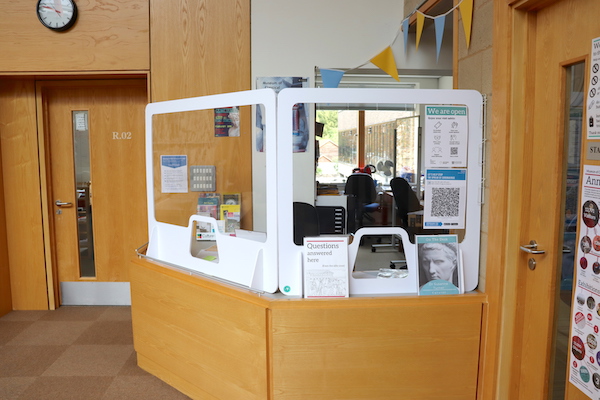
The Front Desk in the Museum is staffed during opening hours. There are no longer any screens on this desk.
Staircases
- The staircase in the main foyer of the Classics building, leading up to the Museum, has 19 steps.
- All staircases in the building have continuous handrails.
- In the main foyer, the continuous hand rail on the right-hand side starts above the first step but on the left-hand side it starts above the second step.
- There are no stair cases inside the Cast Gallery
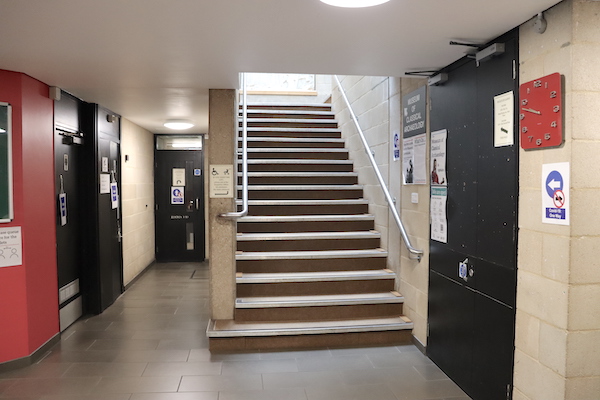
The Museum is accessed via a staircase with a continuous handrail.
Toilets
Accessible Facilities
- The Faculty of Classics has accessible facilities in the main building entrance and also in the lift entrance.
- The facilities next to the lift are larger and may provide more space for manoeuvering than those in the main entrance.
- Both disabled facilities are fitted with emergency pull cords.
- Ambulatory toilets are located in both the Ladies' and Men's facilities at Entrance 1.
- Toilets are fitted with hand-dryers which can be very noisy.
- All the toilets are fitted with lights which turn on automatically.

The disabled and gender neutral toilet in the main entrance foyer is compact and is fitted with baby-changing facilities.

The disabled and gender neutral toilet next to the lift is larger.

There are ambulatory toilets in both the mens and ladies toilets at the main entrance.
Nearest Changing Places Toilet
Unfortunately, we do not have a Changing Places toilet.
The nearest Changing Places toilet is located in the Grand Arcade (contact 01223 457452), approximately 0.6m or a 12 minute walk away (according to Google maps).
Gender Neutral Toilets
The disabled facilities in the main entrance foyer and the lift entrance are designated as gender-neutral toilets.
Baby Changing
Baby changing is located in the disabled facilities in the main entrance to the building.
Evacuation procedures
- Please notify us at the Front Desk when you arrive at the Museum if you have any special requirements in case of emergency.
- The Faculty and Museum are equipped with evacuation chairs.
Seating
- Seats are available around the Cast Gallery for the use of visitors and can be moved.
- Most seating does not have arm rests.
- We ask that you do not sit on any of the side benches.
- You are welcome to use walking sticks or folding stools with seat attachments.
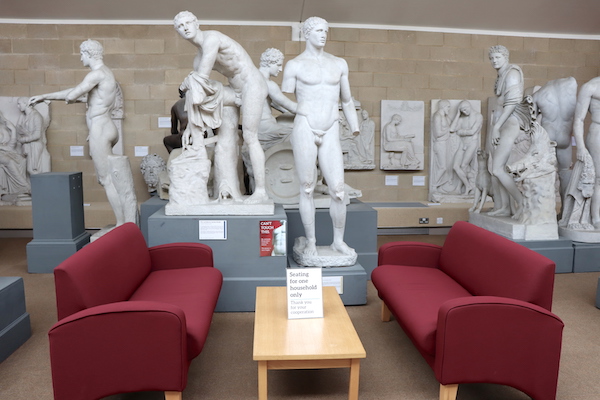
Visitor seating in the Museum is currently restricted to the sofas in Bay F.
Blind and Visually Impaired Visitors
- The Museum is well lit and guide dogs are very welcome.
- Corridors are fitted with lights which automatically turn on.
- Large text versions of the display labels are available in each bay.
- We use lamination for some signs and labels. These may produce glare in direct sunlight.
- Please get in touch to see if we can arrange a touch tour, or check our events listings.
- Manifestations on the glass doors at the main entrance to the building are not very clear.
Deaf and Hearing Impaired Visitors
- The Cast Gallery is carpeted and usually very quiet when there are no school groups.
- There is currently no hearing loop.
Assistance Dogs
Guide dogs, hearing dogs and assistance dogs are welcome. If you can, please let us know in advance if you will be bringing a dog. Dogs should be kept with you at all times.
Dyslexic Visitors
- Large text versions of the display labels are available in each bay.
Visitors on the Autism Spectrum
- The Museum of Classical Archaeology is generally a quiet space (more information below).
- The Sidgwick Site and the Classics Faculty building are usually quieter outside of University term-time.
- You do not need to book your visit in advance, but you can always get in touch in advance if you have any concerns.
- Disability-friendly family openings are advertised on our events page.
- Unfortunately, we do not have any break out spaces.
Companions and Personal Assistants
- There are no barriers to bringing a companion or personal assistant. Entrance to the Museum is free.
Quieter Times
- The Cast Gallery is often very quiet and peaceful - generally more so than other busier museums
- It is busiest when there are events for families or when there are school visits
- It is quietest toward the end of the day
- Our busiest time is February half term. Other school holidays are generally less busy.
- The quietest time of the year is usually December and early January.
- Disability-friendly special openings are listed on our events page.
Light Levels and Temperature
- The Cast Gallery is very well lit during the day, when the sun is shining, because we have a glass roof.
- The Gallery can be darker in the winter months, when the external light is low
- The temperature varies through the year. The Gallery can be cold in the winter months and very hot in the summer months. We recommend layers in the winter and staying properly hydrated with water in the summer.
Website Accessibility
To find out more about the accessibility of the Museum webpages with the Faculty of Classics website or the Museum's separate Online Catalogue, please consult our Accessibility Statement.
Contact Us
For queries about planning your visit or feedback on our provision, please contact us:
Tel. +44 (0)1223 330402
Email museum@classics.cam.ac.uk
Your feedback is important to us as we work to make our space more welcoming and accessible.







